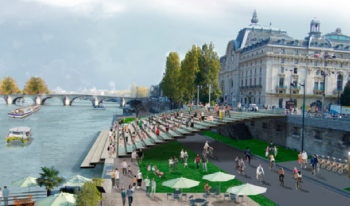
(Image: JC Choblet)
Oh Paris, first you helped me fall in love with bike sharing thanks to your revolutionary Velib system. Now you’ve captured my heart once again by giving your iconic riverfront back to the people. I can only hope it sparks as many copycats as Velib did.
As reported by The Guardian yesterday, the mayor of Paris will move forward with a project to decommission a 2.5 km segment of an expressway on the left bank of the Seine River between the Musée d’Orsay and the Pont de l’Alma (see image at right). Paris will replace surface parking lots and a busy highway with, “a riverside park, pedestrian promenades, floating botanic gardens, flower-market barges, sports courts, restaurants and even perhaps an archipelago of artificial islands.”
And here’s more from The Guardian:
The pedestrianisation of one of Europe’s most picturesque urban riversides means the death knell for the Seine’s non-stop riverside expressways. These were the pride of Georges Pompidou in the 60s when France’s love affair with the car was at its height. Opened in 1967 by him, under the slogan “Paris must adapt the to car”, the dual carriageway with perhaps the best view in France allowed a speedy crossing of Paris from west to east. But environmentalists have long complained it was a dreadful, polluting waste of architectural heritage.
Delanoë [the mayor] promised his new scheme would “give Parisians back their river”, “profoundly change” the city and provide “an opportunity for happiness” for residents. But the mayor, who will not stand for re-election in 2014, also has an eye on his legacy, seeking to be remembered as the man who finally ended Parisian reverence to the car. He has expanded cycle routes and introduced the city’s famous short-term bike-hire and car-hire schemes.
This talk of making picturesque riverfront space hospitable to humans might sound familiar to Portlanders. Activists have long sought to bury the I-5 freeway on Portland’s Central Eastside and replace it with bikeways, housing, and parks. That idea was re-ignited very briefly back in April of this year when outgoing mayor Sam Adams released his “I-5 Tunnel Plan” for public comment.
Unfortunately, not only did Adams’ plan include an arterial roadway in I-5’s place, even he acknowledged that it could take “decades” to actually come to fruition.
While Portland prides itself on a transportation legacy that includes stopping a major federal freeway project and ripping out Harbor Drive on the west side, the fact remains that in many ways, our city is defined by urban freeways and expressways — from the busy NW Naito Parkway that separates hotels and our bustling downtown from Waterfront Park to I-5 on the central eastside and I-405 which separates downtown from northwest and southwest Portland, to I-205, which acts as a boundary that divides our city into two.
One day while biking over the Burnside Bridge into downtown, I stopped and captured this image which shows a side of Portland’s transportation story you never read about in magazines or hear about at conference keynotes…
Unlike Paris (and Seoul South Korea), not only are our local leaders afraid to rein in these massive, outdated pieces of auto infrastructure (for fear that they are perceived as being — gasp! — “anti-car”), they are actually making them even bigger. Metro (yes Metro) willingly approved a project this week to spend $6 million to add one half mile of one lane to I-84 in order to alleviate a few minutes of peak hour congestion; ODOT has hoodwinked PBOT into going along with a $400 million plan that includes adding another lane to I-5 through the Rose Quarter, and of course Portland-area leaders have done little to stop the long and expensive march of the $4 billion, five mile long highway expansion mega-project known as the Columbia River Crossing.
And this isn’t just a transportation-activist-blogger-who-thinks-we-give-too-much-of-our-city-away-to-cars talking. Matthew Yglesias, a noted economics and politics blogger for Slate.com was in Portland this week and he felt so impacted by our urban freeways he devoted a blog post to it. Here’s a snip:
“Where I’m staying near the Convention Center is cut off from the basketball arena and other things right down by the river. The urban core west of the river is cut off from the surrounding neighborhoods by a freeway loop. And the upshot of all this is not only to degrade the experience in the urban areas, it’s to ensure that the residents of auto-centric suburbs have easy access via private car to all the different amenities of the city.”
Portland should definitely be proud of our past; but we should also acknowledge — and do something about the fact — that our present looks nothing like it.
For more on this exciting project in Paris, check out the video below:


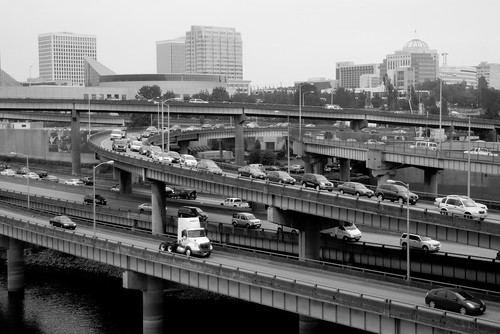

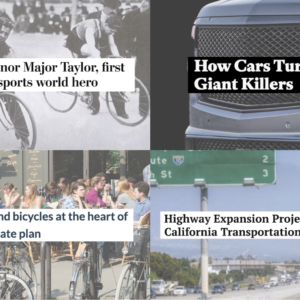
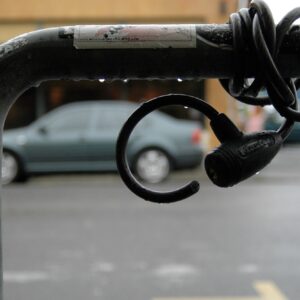
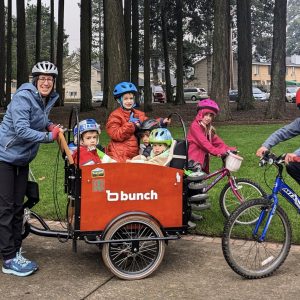
Thanks for reading.
BikePortland has served this community with independent community journalism since 2005. We rely on subscriptions from readers like you to survive. Your financial support is vital in keeping this valuable resource alive and well.
Please subscribe today to strengthen and expand our work.
Reconquete des quais de Willamette!
And just to prove it’s possible in ‘merica, SF has never missed it’s former Embarcadero Freeway which blighted its Embarcadero waterfront area for several decades (and has been gone since the early 90s).
Unfortunately this exception goes a long way toward proving the rule: It took a major earthquake, rendering the structure unusable and expensive to fix, to make that happen. On the other hand there were several sections of the 480 that were never built, as a result of “freeway revolts” in the 60s, not unlike what happened here with the Mt. Hood Freeway.
Ah for the East Portland Beach! Yes, Portland did some exciting stuff in the 70’s, but not much since in challenging the auto domination of the city. I rode over the Burnside Bridge yesterday, wondering why 3 lanes outbound? Why not two and convert that extra 12 feet to an expanded bike/ped promonade on both sides of that bridge with its great views.
Then I looked down at the 10 lanes of I-5/I-84 ramps…what a place for parks, housing, offices, for life along the River! Let’s invoke the corrollary of “Build it and they will come!”…”Remove it, and they will go away!”
Of course, Paris began to discover Seine as space instead of sewer in the late 16th century with the Pont Neuff, so we are about 4 centuries behind.
…and why is there car parking on the Burnside Bridge too (I thought the Feds ended “terrorist truck bomb friendly” parking in the post 9/11 and Madrid events).
In Vancouver the Feds made us take away the car parking under the I-5 bridgeheads and Trimet remove the bike lockers at the Rose Quarter.
Lenny – I agree…
…it was interesting to see the old 1920s lane layout of the Burnside Bridge when the City was resurfacing the concrete desk a few years ago…the middle was taken up by trolley tracks and pedestrian “safety islands”. Imagine similar today and a landscaped median.
Madrid has also undertaken a similar highway-removal project: http://www.nytimes.com/2011/12/27/arts/design/in-madrid-even-maybe-the-bronx-parks-replace-freeways.html
Portland absolutely needs visionaries to step up and run for office. Our political culture is depressingly stale and timid.
Perhaps we could take up highway 101 all along the Oregon coast and replace it with grass?
Its a conspiracy to make us all drive cars!
thanks jonathon
“our city is defined by urban freeways and expressways”
We have five freeways:I-5, I-205, I-405, I-84, and US 26 west of the river. All told there are about 40 miles of interstate within Portland city limits, and US 26 from downtown west can’t be more than an additional five miles. Our city is hardly defined by freeways and expressways, there are more are more miles of bike boulevards than there are of freeways/expressways. Many more.
I disagree- I live in NE, and I’m bounded by freeways. If I want to go any direction, I have to know how and where to cross the freeways. The effect of this infrastructure is huge- much larger than a few sharrows on bikeways…
Fine, you can let the freeways define you if you want, they sure as hell don’t define me or my city. Between bike boulevards, bike lanes, and shared paths like the Springwater, our bike infrastructure dominates our freeway infrastructure in the city.
I don’t think you can really compare bike infrastructure to freeways. It’s more akin to neighborhood streets, or in a few rare cases, arterials or collectors. How many miles of those do we have in the city–that many drivers treat like freeways?
It does amaze me somewhat (can one be “somewhat” amazed?) that prime waterfront property was deemed a good location for freeways as recently as the 60’s. Seems there ought to be at least a few much more economically stimulating uses for such property.
That would be a fair comparison if bike boulevards were 100ft wide…
I take it you’ve never been to East Portland? Maybe sometime you need to ride out to 93rd and tell me that I-205 isn’t a clear wall separating the city.
Thank you so much for this story Jonathan. It still amazes me how car-centric Portland really is, when I randomly wait at a light and count 10 cars go by, 9 of them occupied by one person. In that way, it seems no different from many other cities, minus the tiny percentage of intrepid cyclists. America continues the love affair with the car. Even in the midst of a serious economic recession, recreational car and motorcycle racing is hugely popular, as is motor boat activity. No surprise that gas prices remain high. When will Portland reap the economic rewards of the Washington residents who drive incessantly over to Oregon for shopping and employment? If they’re going to build that bridge, they should pay for as long as the environmental impact lasts (forever).
I have always loved France (even Paris!) and enjoyed this story. Your photo of PDX from the Burnside Bridge was stellar, as is the description: a side of Portland’s transportation story you never read about in magazines or hear about at conference keynotes…
Hey, it so happens I’m in Paris for a vacation. I stood on my balcony on Rue de Charonne (in the 11th, not some far out burb) and counted 100 vehicles in about 10 minutes. Of those 100, 14 were bikes and the other 86 were cars. Let’s not go crazy pretending that Parisians don’t use cars. Anybody who has been stuck in traffic over by the Louvre will tell you that there are plenty of cars on the road here.
Abolish Metro.
Even bicycle-less-than-friendly Boston managed to bury its Central Artery (I-93) in its “Big Dig” project. Mind you, that is the largest civil engineering project in US history. Why not Portland?
I always like to compare Portland’s waterfront to that of Frankfurt am Main, hardly a European glamour city. We have the eastbank freeway, Marquam Bridge, etc across the river from downtown. Frankfurt has a string of half a dozen museums, linked by two bike/ped bridges (one historic), several streetcar lines and U-1, 2, & 3 subway. You can still drive in Frankfurt…German’s love their cars, but why would you and lose a great parking spot!
Great story Jonathan – thanks for being brave enough to call out the car-centric infrastructure and policies that still prevail here in Portland. Sure, many of which are a result of decisions decades ago, but it sure smells like business as usual.
If we keep maintaining cars as our preferred mode of transport – even electric – the carbon load and energy consumption will make our planet a very nasty place in 100 years.
And that’s the funny thing with short-term thinking: one of the few guarantees in life is that the long-term will arrive eventually – time will pass. That may sound sophomoric, but the idea that 100 years from now will definitely come to be renders our present RESPONSE to transportation/livability challenges as less-than-intelligent. We’re simply not reading the writing on the wall.
My natural optimism is getting seriously challenged … but let’s not give up.
“they are actually making them even bigger. Metro (yes Metro) willingly approved a project this week to spend $6 million to add one half mile of one lane to I-84 in order to alleviate a few minutes of peak hour congestion;”
I bet the amount of emissions reduced by not having many, many cars idling for minutes on end might be of some consideration. That being said, the emissions from the building process for the extra lane might offset that.
Expanding freeways does not improve emissions. Any reduced congestion will dissipate as more cars are added to the roadway. Many cities in the U.S. have expanded freeways in an attempt to reduce congestion, sometimes claiming that it will reduce pollution. Where are they now? (Think Atlanta, Houston, L.A., etc)
We are certainly insane, living in the absurd, with our auto and speed cult. I myself have had my corvettes and fast cars until…I found myself being separated from nature and myself, having lost the physical experience that comes from a direct contact with the organic processes of nature…and my own nature. I graduated to a VW beetle bug, but then realized that slow and small are beautiful. I now use an arm-powered handcycle for most of my local travel.
If we survive as a species, future archaeologists and anthropologists will likely be scratching their heads as to what this invention of the horseless carriage/motorcar was all about. Did humans really grasp the monstrous costs to their psyches, the soul, the body, the earth, the community, the air, the water, the atmosphere, and the family? Life itself?
“The heart of the community, the street,
is daily rent apart –
Conversation numbed
By a nervy descant of toxic shock.
Streets, once the open forum of daily life,
Are now the open sewers of the car cult.”
-Autogeddon, 1991
“In terms of translating energy into transportation, there is nothing, neither animal nor mechanical, that is superior to a human being on a bicycle….
-Kirkpatrick Sale, “Human Scale,” London, Secker & Warburg, 1980
…but then the horrid environmental costs of manufacturing those accursed machines know as bicycles, and their arrogant riders despoiling the landscape, withering fragile minds of freethinkers…why not just walk? Not enough political juice in that simple gesture I suppose….
Good move, Paris!
Here’s what it looks like today. There’s a lot of room for improvement.
https://maps.google.com/?ll=48.863148,2.31509&spn=0.012041,0.022316&t=m&z=16&layer=c&cbll=48.863148,2.315298&panoid=g3V4HxQ7G7xwMVIhdMMlbQ&cbp=12,110.06,,0,-6.53
Note, though that they’re just taking out an urban expressway, like Portland did in the 1970s. I-5 is a regional and national highway, and its not as easy to take out as either Portland’s Waterfront Drive or Paris’s expressways are. Or San Francisco’s Embarcadero freeway, which only connected to another freeway at one end.
Seattle could certainly follow Paris’s lead and take out Highway 99 altogether…
Ted Buehler
Great post showing the progress we’ve made, but how small it really is. It’s going to take a while, but as more American cities adopt bike lanes and motorists adopt bicycles well see less and less big money on freeways and more and more spent on modern transportation like the bicycle.
Forget burying I-5 on the eastside. That will cost multiple billions of dollars.
Just decommission it. Rearrange I-405’s ridiculous lane configurations for better flow, rename it to I-5, and blow up the existing I-5 from the I-84 junction down to (and including) the Marquam Bridge.
Wow think of the possibilities for creating a safe network for pedestrians and cyclist with a budget of $4,406,000,000! How much do we spend each year on improvements for pedestrians and cyclist to create a safer and more active transportation network?
20+ years ago, removing I-5 from the east bank was considered by City Council. I advocated to Council that Portland “demolish (I-5), design, and develop” a new riverfront, with esplanade, parks, and dense mixed use development. After the Council voted to keep the freeway in place, then commissioner Earl Blumenauer, came over to me and pledged that within 20 years the freeway would be gone.
Well, 20 years have passed and today we are presented with more freeway enhancements rather than less and the prospect that the largest and most poorly conceived and managed public works project ever (CRC) may be constructed, forever cementing the existing freeway system in place.
Portland is now one of a very few American cities such as Sacramento and Oakland-Berkeley, with a waterfront despoiled by a freeway. SF and Boston removed theirs. Seattle and Buffalo are removing theirs. New York/Brooklyn, Chicago, Baltimore, Philadelphia, Cincinnati and Vancouver USA have or are planning to restore their waterfronts with fabulous parks and developments.
Portland’s riverfront is arguably the most valuable waterfront real-estate on the West Coast. Yet, it is wasted with the tangle of concrete serving mostly intra-city trips. It is defaced with behemoth ugliness such as the Marquam Bridge. And ODOT, PBOT, Metro, and the rest can only propose more.
Shame on Portland.